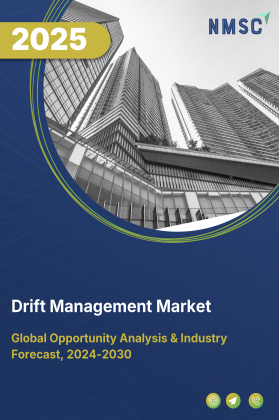
Drift Management Market by Component (Software Solutions, Services), by Deployment Type (Cloud-Based, On-Premises), by Application (IT Operations Management, CD Pipeline Management, Security & Compliance Management, Cloud Infrastructure Management, Disaster Recovery, and Others), and by End-Use Industry (BFSI, Healthcare & Life Sciences, Government & Public Sector, Retail & E-Commerce, Manufacturing, and Others) – Global Opportunity Analysis and Industry Forecast, 2025–2030
Industry Outlook
The global Drift Management Market size was valued at USD 3.55 billion in 2024, with an estimation of USD 4.11 billion in 2025 and is predicted to reach USD 8.48 billion by 2030 with a CAGR of 15.6% from 2025-2030.
The sector is experiencing significant growth driven by the widespread adoption of cloud computing, digital transformation, and rising security concerns. As organizations increasingly migrate to cloud environments, maintaining consistent configurations across dynamic, multi-cloud infrastructures becomes a challenge, heightening the risk of configuration drift. Drift management tools are essential for real-time monitoring and correction, ensuring security, compliance, and cost efficiency.
Additionally, the integration of AI and machine learning offers new growth opportunities by enhancing drift detection, prediction, and remediation. However, high implementation and maintenance costs remain a restraint, limiting the drift management market growth, particularly for smaller organizations with budget constraints. Despite this, the growing need for optimized, secure, and compliant cloud environments continues to drive industry expansion.
Widespread Cloud Adoption Fuels the Market Expansion
As organizations increasingly adopt cloud computing, the demand for drift management solutions grows in response to the complexities introduced by dynamic, scalable, and multi-cloud environments.
According to Network, by 2025, the global cloud computing market is expected to reach USD 912.77 billion. This growth in cloud adoption brings challenges in maintaining consistent configurations across rapidly evolving infrastructures. Cloud platforms offer flexibility through features like auto-scaling and quick deployment cycles, but this also heightens the risk of configuration drift, where infrastructure settings unintentionally deviate from their intended state.
Drift management tools become essential for real-time monitoring and correction, ensuring that security, compliance, and cost-efficiency are maintained. With the growing cloud sector, drift management ensures optimized resource usage and stable, secure, compliant infrastructure.
Rise in Digital Transformation Drives the Market Growth
Digital transformation is a significant driver of the drift management market demand as organizations increasingly embrace cloud technologies, automation, and data-driven strategies. As businesses undergo digital transformation, they modernize their IT infrastructure by adopting cloud services, DevOps practices, microservices, and Infrastructure as Code (IaC). This creates highly dynamic, scalable environments where configurations change rapidly. With frequent updates, deployments, and infrastructure scaling, maintaining consistency becomes challenging, leading to configuration drift.
Drift management tools are crucial for automatically detecting and correcting these discrepancies, ensuring that infrastructure remains aligned with the desired state. As digital transformation accelerates, the need for automated, efficient drift management solutions grows, helping organizations optimize resources, maintain security, and improve operational efficiency in their evolving IT environments.
Rising Security Concerns and Cyberthreats Boosts the Market Demand
Rising security concerns and cyberthreats are driving the industry growth as organizations move more sensitive data and applications to the cloud. Configuration drift creates security vulnerabilities by causing misconfigured access controls, outdated patches, or incorrect security settings, which be exploited by cybercriminals. Drift management tools automatically detect and correct these discrepancies, ensuring security configurations remain aligned with best practices.
By maintaining consistent security protocols (e.g., firewalls, encryption) and ensuring compliance with regulatory standards like GDPR and HIPAA, these tools reduce the risk of data breaches, malware, and cyberattacks. As cyber threats grow, drift management is essential for safeguarding cloud environments and mitigating potential security risks.
High Implementation and Maintenance Costs Limits the Market Growth
One major restraint of the market is the high implementation and maintenance costs associated with drift management tools. While these tools provide significant value in ensuring configuration consistency and security, the initial setup, integration into existing cloud infrastructures, and ongoing maintenance be costly for organizations, especially smaller ones with limited budgets. These costs include purchasing software, hiring skilled personnel for deployment and management, and dedicating resources for continuous monitoring.
Additionally, as cloud environments evolve and technologies change, drift management tools require frequent updates or customization, which increase ongoing operational expenses. This financial burden hinders the adoption of drift management solutions, especially for businesses with limited IT resources.
Integration of AI & Machine Learning Creates New Growth Opportunities
One key opportunity in the drift management market expansion is the integration of AI and machine learning to enhance drift detection and remediation. As cloud environments become more complex, traditional drift management tools struggle to keep up with the scale and speed of changes.
By leveraging AI and machine learning, drift management solutions automatically identify patterns, predict potential drift scenarios, and proactively suggest or apply corrective actions. This could lead to more accurate and faster detection of configuration discrepancies, reducing downtime and human intervention.
Additionally, AI-driven solutions offer predictive analytics to optimize cloud resources and enhance security, making drift management more efficient and scalable, and offering significant value to organizations looking for smarter, automated solutions.
Market Segmentations and Scope of the Study
The drift management market report is segmented by component, deployment type, application, end-use industry, and region. By component, the market is divided into software solutions, and services. Based on deployment type, the market is categorized into cloud-based and on-premises solutions. By application, the market spans IT operations management, CD pipeline management, security & compliance management, cloud infrastructure management, disaster recovery, and others. By end-use industry, the market covers BFSI, healthcare & life sciences, government & public sector, retail & e-commerce, manufacturing, and others. Regional coverage includes North America, Europe, Asia-Pacific, and Rest of the World (RoW).
Geographical Analysis
A key driver of the drift management market share in North America is the rapid adoption of cloud services across enterprises. North American businesses, particularly in industries like finance, healthcare, and technology, are increasingly migrating to cloud platforms to enhance operational efficiency, scalability, and flexibility. As organizations scale their cloud infrastructure, the complexity of managing configurations and preventing drift grows. In this region, there is a strong emphasis on maintaining high standards of security, compliance, and performance. Drift management solutions are essential for ensuring that cloud environments remain secure, compliant, and optimized, aligning with both regulatory requirements (such as GDPR, HIPAA) and internal best practices. The combination of cloud adoption and strict regulatory frameworks drives demand for drift management tools to maintain consistency and reduce the risk of operational and security issues.
Europe’s strong regulatory and compliance requirements are a key driver of the drift management market. With stringent data protection laws like the General Data Protection Regulation (GDPR), businesses in Europe must ensure that their cloud infrastructures remain secure, compliant, and consistent. As European organizations increasingly adopt cloud technologies, maintaining alignment with compliance standards becomes crucial. Drift management solutions help mitigate the risk of misconfigurations that could lead to data breaches, security issues, or non-compliance with regulations. This is particularly important in sectors like finance, healthcare, and government, where the consequences of non-compliance are severe. As cloud adoption continues to rise across Europe, regulatory pressures fuel the demand for effective drift management tools.
Rapid digital transformation is a major driver of the drift management market in Asia Pacific. As countries in the region, including China, India, Japan, and Australia, embrace cloud technologies, businesses are transforming their IT infrastructures to enhance scalability, efficiency, and innovation. According to India Brand Equity Foundation (IBEF), by 2025, the digital economy’s productivity is expected to be five times higher than other sectors, and its share in Gross Value Added (GVA) is projected to reach 20% by 2029-30. This shift increases the complexity of managing cloud environments, which involves integrating technologies like AI, IoT, and Big Data. As these infrastructures grow and evolve, drift management tools are crucial for ensuring that configurations remain consistent, secure, and compliant, supporting operational efficiency and reducing risks in dynamic, cloud-based environments.
The rest of the world is experiencing a significant driver for the drift management market trends due to the growing reliance on automation and DevOps practices. As businesses across emerging markets embrace more agile and automated software development methodologies, the complexity of managing cloud infrastructure increases. DevOps and Continuous Integration/Continuous Deployment (CI/CD) practices encourage frequent, rapid changes to applications and infrastructure, which lead to configuration drift. Drift management tools become essential in automatically detecting and correcting these discrepancies in real time, ensuring that the infrastructure remains consistent, secure, and compliant. With automation and DevOps becoming integral to digital strategies globally, the demand for drift management solutions rises to support continuous development cycles and prevent misconfigurations or security risks.
Strategic Innovations Adopted by Key Players
Key players in the drift management industry are driving market growth through critical vulnerability remediation and advanced platform innovations.
-
In August 2025, Cloudanix has upgraded its Cloud Security Posture Management (CSPM) tools to provide more comprehensive drift detection across multi-cloud environments, focusing on policy violations and security drift.
-
In May 2025, Red Hat enhanced drift management capabilities in hybrid cloud environments. Recent updates focus on integrating Red Hat Ansible and OpenShift to automate drift detection in cloud-native deployments.
Key Benefits
-
The report provides quantitative analysis and estimations of the industry from 2025 to 2030, which assists in identifying the prevailing drift management market opportunities.
-
The study comprises a deep-dive analysis of the current and future drift management market trends to depict prevalent investment pockets in the sector.
-
Information related to key drivers, restraints, and opportunities and their impact on the market is provided in the report.
-
Competitive analysis of the key players, along with their market share is provided in the report.
-
SWOT analysis and Porters Five Forces model is elaborated in the study.
-
Value chain analysis in the market study provides a clear picture of roles of stakeholders.
Drift Management Market Key Segments
By Component
-
Software Solutions
-
Configuration Monitoring Tools
-
Drift Detection Tools
-
Automation Platforms
-
-
Services
-
Consulting & Implementation Services
-
Drift Management Services
-
Support & Maintenance
-
Others
-
By Deployment Type
-
Cloud-Based
-
On-Premises
By Application
-
IT Operations Management
-
CD Pipeline Management
-
Security & Compliance Management
-
Cloud Infrastructure Management
-
Disaster Recovery
-
Others
By End Use Industry
-
BFSI
-
Healthcare & Life Sciences
-
Government & Public Sector
-
Retail & E-Commerce
-
Manufacturing
-
Others
By Region
-
North America
-
The U.S.
-
Canada
-
Mexico
-
-
Europe
-
The UK
-
Germany
-
France
-
Italy
-
Spain
-
Denmark
-
Netherlands
-
Finland
-
Sweden
-
Norway
-
Russia
-
Rest of Europe
-
-
Asia-Pacific
-
China
-
Japan
-
India
-
South Korea
-
Australia
-
Indonesia
-
Singapore
-
Taiwan
-
Thailand
-
Rest of Asia-Pacific
-
-
Latin America
-
RoW
-
Middle East
-
Africa
-
Key Players
-
Chef Software Inc
-
HashiCorp, Inc
-
ManageEngine
-
CFEngine
-
Arcon Technologies
-
Cloudanix
-
Firefly AI
-
Envo
-
Continuity Software
-
Google LLC
-
Cisco Systems, Inc
-
Datadog, Inc
-
BMC Software, Inc
Report Scope and Segmentation:
|
Parameters |
Details |
|
Market Size in 2025 |
USD 4.11 Billion |
|
Revenue Forecast in 2030 |
USD 8.48 Billion |
|
Growth Rate |
CAGR of 15.6% from 2025 to 2030 |
|
Analysis Period |
2024–2030 |
|
Base Year Considered |
2024 |
|
Forecast Period |
2025–2030 |
|
Market Size Estimation |
Billion (USD) |
|
Growth Factors |
|
|
Countries Covered |
28 |
|
Companies Profiled |
15 |
|
Market Share |
Available for 10 companies |
|
Customization Scope |
Free customization (equivalent up to 80 working hours of analysts) after purchase. Addition or alteration to country, regional, and segment scope. |
|
Pricing and Purchase Options |
Avail customized purchase options to meet your exact research needs. |

















 Speak to Our Analyst
Speak to Our Analyst

























